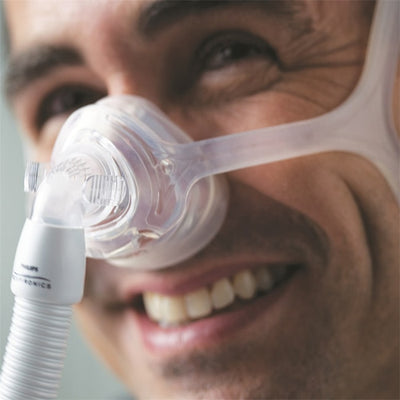When used properly, a CPAP machine can be highly effective at keeping the negative effects of obstructive sleep apnea under control. However, when air leaks occur, your treatment won’t be nearly as effective as it should be.
In fact, it might not be of much help at all. A recent study published in the January 2023 issue of Respiratory Care found that air leaks can even interfere with CPAP machine performance, keeping automatic CPAP machines from responding properly to sleep apnea incidents. And of course, leaks can keep CPAP patients from getting sufficient airflow to prevent sleep apnea incidents in the first place.
The good news is that the majority of the causes behind CPAP air leaks are easily identified and fixed. Most involve either the mask or tubing, and once you know what to look for, you can have confidence in your ability to keep leaks from becoming a recurring problem.
1. Confirm You’re Using the Right Mask Style

Your sleep position will have a direct impact on the type of mask that is best suited for your needs — and that will be the least likely to leak. A sleep specialist can help you determine which type of mask is best.
For example, stomach sleepers often press their face against their pillow in a way that makes it hard for full face masks to stay in place. The mask could easily come loose during the night, disrupting airflow. Because of this, it is generally recommended that stomach sleepers use small nasal pillows instead. Nasal masks and nasal pillows are also usually recommended for side sleepers and those who roll around a lot in their sleep.
Alternatively, a full face mask is best for those who often breathe through their mouth at night. If someone who breathes through their mouth uses a nasal mask, the air delivered by their CPAP machine would likely escape out their open mouth instead of getting to the lungs.
2. Double Check the Sizing of Your Mask
Even when you have the right type of mask for your sleep style, you could still experience air leaks if your mask is the wrong size. This is more common than you might think, as sizing guidelines can actually be quite different depending on the manufacturer you buy from.
In addition to the mask itself, you must also pay attention to the sizing of the mask cushions and the frame to ensure that it all conforms properly to your face. It’s always a good idea to double check your mask manufacturer’s sizing guidelines — or to even do a professional fitting — to ensure that you get the right size of mask for your face.
3. Readjust Your Headgear

The mask itself isn’t the only thing that could cause air leak-related issues. Quite often, air leaks occur when the headgear (which holds your mask to your face) hasn’t been adjusted properly.
Headgear should be adjusted after you lie down in bed so that you can achieve a comfortable fit. By adjusting the headgear after you lay down, you ensure that it doesn’t get knocked loose as you get into bed.
The mask should be snug, but not too tight against your skin. When the mask is too loose, gaps could form between the mask cushions and your skin, allowing air to escape. On the other hand, a mask that is too tight could prevent mask cushions from inflating properly, contributing to leaks while also irritating your skin.
4. Replace Your Mask and Tubing
Even when you have the right mask setup and know how to fit your mask properly, it will eventually leak. That’s because the various parts that make up your CPAP mask system will wear down over time. The elastic for your headgear will get stretched and worn. Silicone mask cushions can get small tears and wear down, making it easier for air to leak out. Tubing can also develop small cracks that result in air leaks.
Following your manufacturer’s guidelines for replacing these and other components will help prevent air leaks from becoming a major problem. As a general guideline, most manufacturers only require that you replace the mask frame and tubing after three months. And the headgear will usually last for about six months. However mask cushions need to be replaced much more frequently — typically every two to four weeks.
You should also carefully follow mask cleaning guidelines to ensure that these components work like they should for their expected lifespan. Long-term exposure to dirt and oils from your skin can actually deteriorate silicone mask cushions, and significant buildup can make it harder for them to form and maintain an airtight seal. Cleaning the mask each day (and washing your face before using it) will prevent bacterial buildup and keep everything working like it should.
Make CPAP Air Leaks a Thing of the Past!
By taking care of your CPAP equipment and using it properly, you can avoid the air leaks that compromise the quality of your sleep apnea treatment. You’ll enjoy higher-quality sleep that leaves you feeling rested and rejuvenated, while also avoiding the negative side effects associated with poor sleep.
Of course, buying replacement CPAP equipment — even masks and tubing — can put quite a dent in your budget, especially if you don’t have health insurance. This is where Help Medical Supplies comes in. With discounted prices on CPAP masks and tubing, as well as fast and free shipping on orders of $99 or more, you can save big on replacement equipment from leading brands without lowering your quality of care.

